In the Archives: Carp-ocalypse
Editor’s note: Faced with evidence that Asian carp have managed to find their way past an electrical barrier, earlier this month Gov. Jennifer Granholm called for aggressive action to prevent the fish from entering the Great Lakes: “In the meantime, we must use every available tool at our disposal to protect the Great Lakes, including closing the locks, expanding eDNA testing and applying additional rotenone as necessary.”
This week, The Chronicle’s local history columnist Laura Bien takes a 40-year look back into the past at the use of rotenone on a local lake – Ford Lake. That body of water received a passing mention in Matt Naud’s environmental indicator column on phosphorus – it involved a 1991 algal bloom. But back in the early 1970s Ford Lake wasn’t blooming algae, it was blooming fish.
In 1973, the Michigan Department of Natural Resources wanted to turn Ypsilanti’s Ford Lake into a fisherman’s paradise. They planned to stock it with muskellunge, rainbow trout, and large- and smallmouth bass.
The only problem was the lake’s population of “rough fish” – mostly the common carp, plus bullheads and suckers. Carp are not native to Michigan. They were introduced in the late 19th century by the era-equivalent of the DNR as a valuable food fish that was cheap to keep on artificial ponds dug on farmers’ land. The farmers’ aquaculture projects inevitably spilled into Michigan waterways.
A century later, the DNR planned to douse Ford Lake with the piscicide rotenone to kill the carp and other rough fish, then whisk the remains into the Ypsilanti Township landfill and restock the pond.
Instead, the project led to a statewide ban on rotenone.
The first step was to lower the lake level. Rotenone was expensive, and a smaller quantity of lake water would mean less poison. Upstream organizations in charge of various sections of the river and its dams agreed to help. The dams closed, and the level of water in Ford Lake dropped by a yard.
One setback at the beginning of the project presaged the disaster to come. After the rotenone had been delivered and stored on the banks of Ford Lake, someone decided it would be a hoot to roll the 50-gallon metal barrels into the water. Scuba divers had to be hired to fish out the barrels.
The local organization overseeing the project was JYRO, the Joint Ypsilanti Recreation Organization. JYRO expected that a thousand or so volunteers on shore and in boats would assist in the cleanup, based on an informal survey of local residents. The organization scheduled the task on Mother’s Day weekend. JYRO expected so many private boats to turn out on the lake that the DNR sent down a special marine safety boat to supervise the fleet.
On May 10, the barrels of rotenone were loaded onto a few small motorboats and laid on their sides, two to a boat. Hoses led from the openings in the can lids, running along either side of the boat pilot, and extending over the stern into the water churned by the power motor. Sitting a foot or two from one hundred gallons of poison, the pilots were not furnished with protective gear.
Rotenone was harmless to humans, said DNR fish biologist Walt Root, as quoted in the May 9, 1973 Ypsilanti Press. “‘It’s a dehydrating agent,’ he explained. ‘I had a mouthful of it once as an experiment, and it dries your mouth. Fish are highly allergic to it . . . [i]t causes the blood vessels to shrink in the gills.’” The paper added, “Labels on the drums, however, indicate the chemical is toxic.”
“The boats skimmed gingerly across the lake,” stated the May 11, 1973 Ypsi Press, “depositing the liquid in their spray.” The poison sank into Ford Lake’s murky depths. Dead fish began to wash up on shore.
The newspaper presented this as a culinary opportunity.
“Anyone who can make it to the banks of Ford Lake,” suggested a May 11 Press article, “can take home all the fish he can eat for the next few days in the wake of [the fishkill]. The thousands of dead fish, mostly carp, are free for the taking. JYRO officials say they must be carted away and are giving area residents first crack at the kill.”
Food writer for the Press, Dorothy Zack, seized the occasion to publish fish recipes. Her May 15 column headlined “Lots of fish around gives new menu ideas” said, “The fish kill in the waters of the Huron River and Ford Lake bolstered household stocks of fish for the dinner table . . . those that went into the freezer are still waiting for new recipes.” She advised dipping filets in whipped eggs and coating them in cracker crumbs or cream of wheat. The photo accompanying the article depicted a massive slab of salmon that dwarfs the smaller filets available in supermarkets today.
Residents didn’t bite.
But “fishing” with rotenone wasn’t such a far-fetched idea. Derived from the roots of plants in the pea family, rotenone had been used for years by indigenous people in South America and Australia for fishing. When the plant roots were crushed and thrown into the water, dazed fish would surface for capture and consumption. The use of plants containing rotenone or other poisons for fishing was widespread. Various Native American peoples used black walnut, horse chestnut, poke, and other plants. Fishing with poison was practiced in the Pacific Islands, India, and Africa – in fact, on every continent.
Rotenone works by absorption into fish gills. Though the World Health Organization classifies rotenone as a “moderately hazardous” poison, and a link to Parkinson’s disease has been suggested by clinical trials, it is generally poorly absorbed in the human digestive tract, though deadly to fish. Rotenone breaks down quickly in the environment. It’s also used as an insecticide and pesticide. The DNR had used rotenone in Michigan since the 1930s.
Nevertheless, the crowds of eager fish-harvesters, shore-cleaners, and the fleet of boats never appeared on Ford Lake. Dead fish continued to accumulate.
Then someone in charge of the dam at the south end of Ford Lake opened it by mistake. Poisoned water poured into Belleville Lake. In its morning May 14 edition of the newspaper, the Press called it a “mishap.” By the evening edition, the story had expanded and the headline had changed to “Thousands of fish killed in Belleville.”
The May 14 Press quoted DNR fish biologist Ed Bacon, who “said the poisoning was embarrassing . . . ‘Dead fish do smell, and sometimes they smell all the way to Lansing.’” His words would prove prophetic.
As the fish continued to pile up on Ford Lake’s shoreline, large black flies appeared. Rats were seen, some shot with an air rifle. The handful of cleanup staff worked desperately to shovel up and bag the fish and heave the bags into a front-loader, but they couldn’t keep up.
Irate calls were coming in to Gary Owen, a Democratic state representative involved with the cleanup. He authorized a group of 105 state prisoners to transfer from Pontiac to Ford Lake to help pick up fish.
The paper issued an invitation to residents to come down to the now-fetid shoreline, mingle with the felons, and pick up fish corpses.
Invitation declined.
“[JYRO] is mad because too few citizens have come out to help,” said the May 18 Press. “JYRO was counting on the help of close to 1,000 volunteers, that estimate drawn from responses received before the planned fish kill. But E. L. Abbott, JYRO chairman, says only about 25 people have come out.”
The original estimate of 150 tons of fish carcasses had been surpassed days ago. Dead fish kept coming. In desperation, a makeshift “road” was plowed down one steep lake bank for the front-loader. This road consisted of a section of lakeside scraped bare and at an angle so precipitous that in another era it might qualify for its own reality show. The front loader crept carefully up and down the slope, and the tonnage of fish continued to climb.
The community hoped for relief. On May 22, the paper published an article optimistically headlined “Fish clean-up almost finished,” though in fact the effort was only a little over halfway done. Four-hundred tons of fish had been removed. The prisoners and cleanup workers had left the project. “But [state fish biologist Walt] Root didn’t see that as posing any problem,” the article indicated, “as all the remaining fish are on the south side of the lake and away from residential areas.”
The following day’s Press story, headlined “Fish outlook good in two area lakes,” was even more upbeat. “At Ford Lake, DNR has begun restocking the lake while cleanup of dead fish continues,” it said. “About 92,000 rainbow trout were put into the lake Tuesday and before the week is out DNR plans to stock 100,000 smallmouth bass and 1.75 million walleye fry . . . in the future, there are plans to stock pure-bred muskies, large mouth bass, hybrid sunfish, and channel catfish. Ed Bacon, DNR fish biologist, said the potential for fishing in Ford Lake was ‘terrific.’”
One day later, the DNR issued a statewide ban on rotenone.
“The accidental killing of thousands of fish in Belleville Lake has prompted a temporary ban by the Department of Natural Resources on chemical fish kill projects in Michigan’s lakes,” said the May 24 Press.
The ban didn’t last long, however; that fall the DNR proceeded with a rotenone fishkill in Belleville Lake, as planned months prior. Cooler temperatures alleviated smell problems. The smaller project was completed. The Ford Lake fishkill saga had ended.
A July 2010 walk on the boardwalk in Ford Lake’s North Bay Park offers a chance to pause on the birdwatching platform near a reedfield and examine the foot-deep lake bottom, rippling in wavy light.
Carp-sign consisting of squiggly S’s in the sand reveals where carp in the shallows wiggled around in the warm water, looking for delectables.
Carp love canned corn and bread bits. Leftover spaghetti and pieces of old hot dog buns are their foie gras. They even like canned peas, possibly the only organism who does. You may as well bring some nummies to the park next time, in homage to this ineradicable fish. Despite poisons, front-loaders, trucks, state representatives, improvised roads, drained lakes, fish-plucking felons, and the efforts of an entire state’s Department of Natural Resources over decades . . . they’re not going anywhere.
This biweekly column features a Mystery Artifact contest. You are invited to take a look at the artifact and try to deduce its function.
Last column’s Mystery Artifact elicited some creative guesses. Lisa Bashert guessed a griddle (close enough), abc guessed a crepe pan (close enough), cosmonican guessed a pancake griddle (nailed it).
The tag on this recent Ypsilanti Museum acquisition says it is a “pan-cake” griddle meant for use on a hearth.
This week’s artifact is another recent museum acquisition currently in storage. Can you guess its function? Hint: It came from the same recently-acquired collection as the pancake griddle. Good luck!




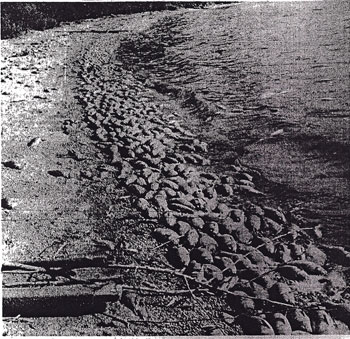
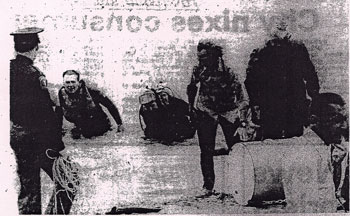
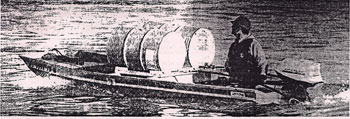
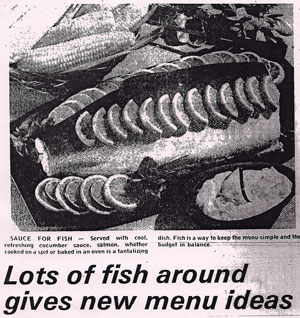
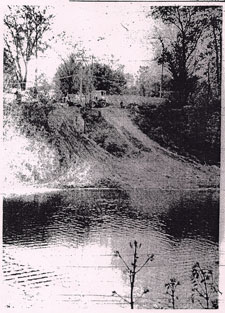

I love Laura Bein’s articles! The mystery object looks like a sandwich toaster to me, we used something that looked very similar when camping :)
Siani: Thank you for your very nice comment! :) Sandwich toaster is a very good guess; answer next column.
Hilarious story, especially the earnest damage control by the DNR guys. I wonder what they think now?
Thank you for your nice comment, Rod. Ran across this story while reading old microfilm and my jaw dropped as it just got worse and worse. It’s an epic tragicomedy about our relation to wildlife. I think I too would have passed on the “bonanza” of free fish.
p.s. Oh, to actually answer your question, I contacted a DNR person involved at the time but due to short notice on my part (not his fault) he didn’t get back to me. If he does I’ll post what he says.
Epic tragicomedy is about right.
I will second the first guess of sandwich toaster, also known as a cooking iron.
To clarify the past item, I found that that is most likely to be known as a Bannock Griddle, for making a Scottish flat bread, or pan cake, called a bannock or scone (but not what we would call a scone now) — made with rye flour, baking soda and water. Therefore, I decline the honor of having nailed anything, in fact I think Janice Anschuetz was closer with her Hoe Cakes than anything we might think of as a pancake.
What a great article. Thorough research and the perfect tone. I particularly like the bit about the eating habits of carp. My children will attest to the fact that carp must be the only organisms that like canned peas…
I remember the fish kill from that time period. The smell of rotting fish wafted all over the area and most people avoided that side of town. It seemed like months before smell went away. Growing up in Ypsilanti at that time, we always avoided Ford Lake due to the pollution and fact that the water was so murky looking. When the lake level was lowered, I recall seeing lots of discarded trash, cars, appliances etc., visable along the new shore. Little islands appeared that had been invisable before the lake water level changed. I still wonder what might yet be lurking below that lakes murky depths. Possibly Fordie, the Ypsi sea serpent?
Great story. Not being an angler, are there trout, bass, or muskies currently in Ford Lake, or was this entire escapade a lost cause?
If the mystery object is a catfish scoop, that could explain the clean-up’s unexpected duration.
Cosmonican, you raise an important point–sometimes things are not what their museum tag or label says they are. I saw this just the other day when scanning a picture. Someone had written on the back that the subject was the daughter of X and Y…but X and Y were her grandparents. Your point about a Bannock Griddle is well taken. I’ll see if I can find out more about this item so that we can pin it down.
Jeff: Thank you for your very kind comment. Wait, I thought I was the only one who knew that carp liked canned peas. Looks like the secret is out. :)
Dave: one thing that is in there is a complete submerged bridge. The bridge was there before Henry Ford dreamed up and created the lake in the early 30s. One old-timer told me that they let the lake overflow the iron truss bridge so that just the top part was sticking out; kids skated around it that winter. In the spring, officials allowed the upstream dam to open and allowed the surge of ice and water to knock it over. According to said old-timer. It’s still in there.
Brad: Thank you for your nice comment.
Some of the interesting stuff I found about this subject that didn’t make it into the article concerns lakes’ trophic states. [link] This is a means of classifying lakes by the amount of nutrients in the water, from oligotrophic (few nutrients) to mesotrophic, eutrophic, and hypereutrophic (dense with nutrients, murky water, lots of little organisms, duckweed, &c).
Ford Lake is eutrophic, or, fairly nutrient-rich. The point of my rambling about trophic states is that different fish prefer different trophic states. Muskies, some of the fish restocked in Ford Lake in 1973, apparently prefer mesotrophic waters. Here’s a neat little graph showing which fish prefer which trophic state: [link]
Annnyways, I’ve heard that there are crappie, bass, perch, some walleye and of course lovely carp in Ford Lake.
I appreciate the pro-carp tone of this article. I have long believed that the Asian carp are unfairly maligned for their qualities that are annoying (to humans) when they (the carp) are simply doing what they are supposed to do in the scheme of evolution: adapt and thrive. It is human hubris to think that we can maintain ecosystems in their “native” form in a constantly changing and intermixing global environment. If I were a carp I would say, “We’re fitter. Deal with it!”
Fred: Thank you for your comment. Of course, we both know there’s a world of difference between the giant Asian carp and the common carp–though some would say the common carp has done its own part in damaging Michigan waterways. They are fun, however, to watch in the shallows, audibly slurping the lily pads and hoovering up tidbits.
Impossible to measure, but I have to wonder how many of those carp got started in the lake by students leaving town, and flushing their pet goldfish down the toilet.
Cosmonican: My husband and I enjoy walking on the boardwalk in North Bay Park and visiting the lovely chain of islands. On one such walk I saw a big, bright orange goldfish in the water. It looked like a pet that had been put in the water and that had grown to a not insignificant size. I’ve read that goldfish are pretty rugged and can survive in poor conditions. So far as I know, that goldfish is still exploring the depths of Ford Lake.
Jeff, I have to point out for the record that at least *two* organisms must taste like canned peas, the other being peas, when canned.
Rod: Thanks to the offbeat topics that appeal to me, and not to brag, but an old story of mine is the #1 Google result for “hair microbes.”
I’m hoping that this discussion leads to another top spot for future searches for “carp + canned peas.” Fingers crossed! :D
The iron suspension bridge was built in 1885, flooded in 1930, and is indeed still there, sitting on its side. There was a story about it in the Ann Arbor News on July 27, 2008. This link might work: [link]
Jim: the link does work; thank you! Minor quibble: Henry Ford created Ford Lake in 1932, not 1930. Looked through my files to find a 1932 story but didn’t find it; here’s a Google books reference: [link]
The French like canned peas too.
Sally: I learn something new every day. :)
Laura: I hear you. I think I’m directly responsible for every instance of “toboggan porn” on the internet. Including this one, now.
Rod: High five for a fellow weird-search-terms-Google-bomber! Yeah! o/\o
Jim: Double-checked on the Ford Lake creation date to make sure I wasn’t giving you bad info. In my files I have several “year” files, and in the 1932 one is a copy of the paper for the December Ypsilanti Daily Press. It has a chronology for the year 1932. Here are some dates of interest:
Oct. 18 1932: New road and bridge opened, running over the top of the new dam.
Oct. 21, 1932: Dam officially closed on the river, beginning the impoundment that led to Ford Lake.
Of course there was a lot of work leading up to this, beginning in 1931 with some coffer dam work (found an article about same in Oct. 15, 1931 Press in files) but I think of the Official Dam Closing as the true start of the lake. I guess someone could argue that but just my two cents.
I remember our class taking a ‘field trip’ walking from East Junior High over to see the dead carp and the lake when this happened and it was horrible smelling. The bunk-est field trip EVER-lol!
p.s.
And there WERE people bagging them up and taking them home with them that day!
Judy: That is absolutely hilarious. Thank you for telling us about the field trip. And the paper invited people to take fish home “over the next few days…” in other words, after the deceased fish had been bobbing in the warm summer shallows or washed up on the beach in the sun for a few days…mmmmmmmm! :)
p.s. Double-checked the griddle museum card and here is exactly what it says; turns out it’s an artifact from Ann Arbor:
“Pan-cake griddle for fireplace. Used in the family of Dr. Henry Shetterly, Ann Arbor, in 1840 & donated by his daughter, Mrs. James Lewis.”
It’s a pretty specialized cooking implement; it makes sense that a relatively well-off person would own it, assuming that as a doctor Shetterly was a bit better-off.
re #31: I’ll stand by my retraction; stubborn that I am. Truly a person would have to be quite well off to eat pancakes often, considering all the eggs and milk, and butter, and fine ground flour; not to mention syrup, not cheap even now. And Ann Arbor was still in the wilderness in 1840, that doctor paid in firewood and furs.
So when did “a penny for your thoughts” stretch to “my two cents”? Must be inflation.
Cosmonicon: Yep, you likely are right (I was just reporting what was on the tag, but I have no idea if that’s correct; now that you mention it, pancakes do involve ingredients that would seem to be unlikely in a frontier-ish settlement). Perhaps it was used for humbler bakeables, like hoecakes or the like. I should sniff around and see if there is information out there about this unusual type of artifact and what it was used for.
The mystery artifacts are great fun. My daughter Bec and I believe it is a shovel for removing the askes from under the grate of a wood fire.
Irene: Thanks for your nice comment. Interesting guess…we’ll find out next column! :)
Good article. I’ve been looking for info on this very topic, including the sunken bridge, for years!!
I would like to point out that the poisoning, restocking, and continuing management has been a success overall.
Pre-poisoning, the lake was considered devoid of sport-fishing opportunities. Now it is well known for its walleye and smallmouth bass fisheries. It is one of the few lakes that I can think of anywhere where one can shore-fish for walleye with great success.
FYI, trout stocking failed–too warm and shallow. To my knowledge, native muskies (i.e. great lakes or northern muskellunge) were never planted. However, tiger muskies (pike/muskie hybrids) were introducted during the tiger muskie fad of the late 70′s/early 80′s. Since they don’t reproduce, they are no longer present.
On that same note, the lake is also internationally known for the gigantic carp it (still) serves up :-). Carp are very popular in european countries, and they are considered sport fish in the UK.
David: Thank you for your nice and quite interesting comment. I enjoyed learning more about the fish population. Also, had never known about the exotic tiger muskie [Googles same...] whoa, sounds like a pretty fierce fighting fish–big, too.
Walleye in Ford Lake surprises me–I thought walleye only liked extremely clean water.
We used to pull fairly monstrous carp out of the river at Gallup Park (using canned corn, not peas). I would never have dared eat them, but they were fun (and easy) to catch.
Hey – we’re featuring this article on Absolute Michigan: [link]
I have to give the Chronicle kudos for having the wisdom to employ Laura – she’s great!
Wow, talk about a nice compliment. Thank you for the feature, Farlane. Your super-nice remark and gesture reflects more about you than me. :) Also, I love the photo you paired the article with, by Ypsilanti’s own very talented expert photographer Matt Callow. It’s beautiful, and has a brooding portentous mood that complements the article perfectly; good call!
I look forward to reading Ms. Bien’s articles – they are each gems.
For those interested learning more about Matt Callow, here’s a link to a (pre-Chronicle) Teeter Talk interview he did with Dave Askins, who’s also known as HD and is now editor of The Chronicle.
Ms. Bien is also an Alum of the Totter – though the interview dates back to 2006, the issues she discussed, including bus service to Ypsilanti, are still quite relevant.
Your kind comment about the articles I feel privileged to have in the Chronicle makes my day Ms. M.; thank you! :)